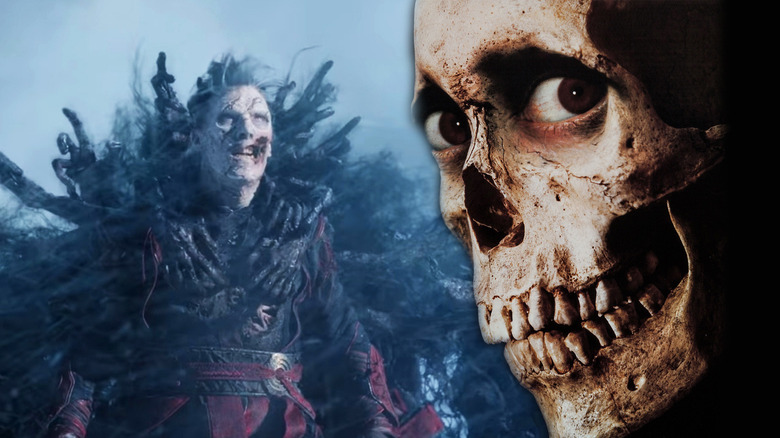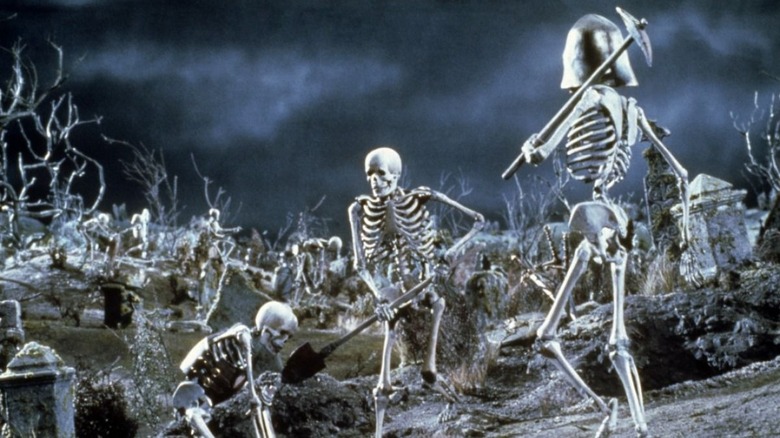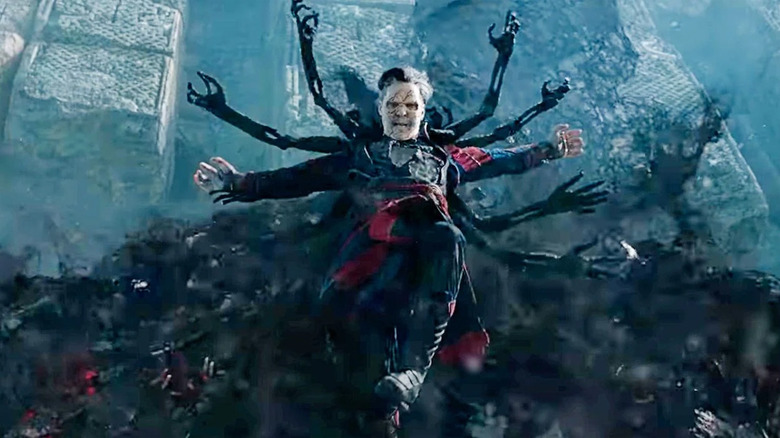Sam Raimi Loves A Good Skeleton (Even In A Marvel Movie)
Two decades after his first Marvel film, Sam Raimi returns to the IP with "Doctor Strange in the Multiverse of Madness" — and boy, does this feel like a uniquely "Raimi" production. The movie is the 28th in the Marvel Cinematic Universe, and it dovetails from the previous films nicely, while managing to continue storylines from the recent Disney+ Marvel miniseries. While there is a certain MCU quality that these movies can never escape — even visionary director Chloé Zhao struggled to meld her indie approach with the necessary story beats in "Eternals" — Raimi managed to elevate the basic story in his "Doctor Strange" sequel, finding various ways to incorporate his signature aesthetic and charm into a very exposition-heavy MCU entry.
Sam Raimi may be best known today for his landmark 2002 film "Spider-Man," which indirectly laid the groundwork for 2008's "Iron Man" and the rest of the MCU. The Tobey Maguire movie was a huge critical and commercial hit, garnering rave reviews and grossing $825 million on a $139 million budget. Even after twenty years of regular superhero movie releases, that first "Spider-Man" movie still holds up: it's exciting, the effects are well done, and — most importantly — it manages to be both grand and earnest at the same time. And let's face it: Willem Dafoe as Norman Osborn aka Green Goblin might be the best villain casting of all time.
While "Doctor Strange in the Mulitverse of Madness" is far from the triumph of that earlier Marvel movie, it still shares that general "Raimi" feel that is so downright entertaining. What's more, because the content deals with the supernatural, Raimi was able to bring his passion for horror into the mix. From the Bruce Campbell cameo to the point-of-view shows putting viewers inside the action, "Doctor Strange in the Multiverse of Madness" fits in with Raimi's filmography comfortably alongside his horror offerings.
Oh, and there are skeletons.
Raimi likes skeletons ... a LOT
Not to sound hyperbolic, but Sam Raimi changed horror forever with "The Evil Dead." The movie was weird, it was gory, it was gross, and it was hilarious. The 1981 original was followed by a soft reboot, "Evil Dead II" in 1987, and the trilogy was concluded in 1992 with "Army of Darkness." Although the latter film was less of a success — it was much more expensive to make, and while it made back its money, it wasn't a major hit — it developed a cult following. I like to think it's because of the skeletons.
While the "Evil Dead" movies mainly used the "deadite" monsters (demons who have possessed the living and taken on a zombie or ghoul-like appearance), "Army of Darkness" also features an entire army of skeletons — reanimated by Ash taking the "Necronomicon Ex-Mortis" without properly saying the necessary phrase. It's kind of what everyone remembers about that movie; the puppet skeleton arms reaching up from the ground to grab Ash, and the epic scene of an entire skeleton army marching to battle, are extremely fun and joyful moments in the fantasy horror. My personal favorite are the Scottish skeletons complete with tams and bagpipes.
Skeletons pop up in other Raimi projects, usually when you least suspect it. In 2002's Spider-Man, when the Green Goblin's bomb turns people into skeletons before obliterating them completely. Even Raimi's TV project "Xena" has fun with skeletons — most memorably, when the titular heroine "gave birth" to one during a hallucination in the season 5 episode "Them Bones, Them Bones." It should really be of no surprise then that "Doctor Strange in the Multiverse of Madness" also features some lovely skeletal remains — heck, there are even skeletons on one of the final posters for the movie.
Doctor Strange is no stranger to skeletal remains
Early on, there are a few skeletons hidden in "Doctor Strange in the Multiverse of Madness." The most obvious is the skull on America Chavez's (Xochitl Gomez) jacket. There's also a skeleton on the wall in Billy and Tommy's room. While these are cute nods to one of the director's favorite horror visuals, it's not long before we get the real deal. We see the Scarlet Witch (who is super evil now) reducing people to their bones. We even see Doctor Strange become a sort of deadite himself, when he "dreamwalks" in the corpse of a dead alternate version of himself. Oh, and we get some very skeletal demons.
One of the highlights of "Doctor Strange in the Multiverse of Madness" is the appearance of the Souls of the Damned — demonic beings that protect their realm, attacking Stephen for daring to essentially practice necromancy. These beings are given a distinctly skeleton-like appearance, especially the arms. The forearms of a skeleton are distinct because typically there are two bones with a gap between: the radius and the ulna (even animals often have dual bones in their forelimbs). There are so many shots of these wretched limbs reaching out that it's impossible not to think of that amazing "Army of the Dead" scene.
Not only are there ample skeletons in "Doctor Strange in the Multiverse of Madness," but also Stephen Strange himself seems oddly comfortable around (and inside) them — perhaps from all that time he spent cutting up the human body as a surgeon? One's thing for sure: Raimi sure likes 'em!
"Doctor Strange in the Multiverse of Madness" is in theaters now.


